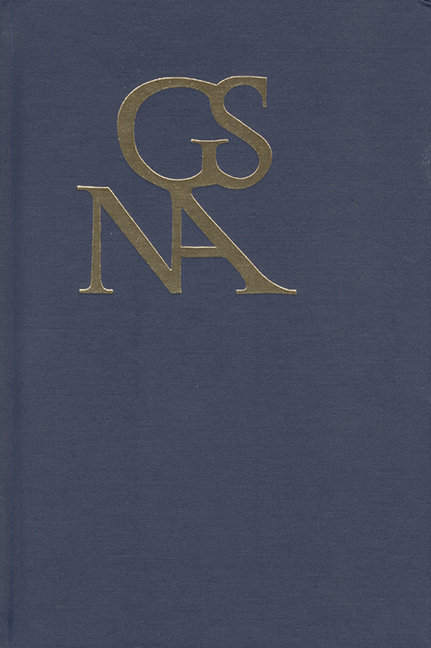Book contents
- Frontmatter
- Contents
- Special Section on What Goethe Heard, edited by Mary Helen Dupree
- What Goethe Heard: Special Section on Hearing and Listening in the Long Eighteenth Century
- Behind Herder's Tympanum: Sound and Physiological Aesthetics, 1800/1900
- Becoming the Listener: Goethe's “Der Fischer”
- Of Barks and Bird Song: Listening in on the Forgotten in Ludwig Tieck's Der blonde Eckbert
- Garden Empire or the Sublime Politics of the Chinese-Gothic Style
- Die Austreibung des Populären: Schillers Bürger-Kritik
- Goethe and the Uncontrollable Business of Appropriative Stage Sequels
- Repetition and Textual Transmission: The Gothic Motif in Goethe's Faust and “Von deutscher Baukunst”
- “Die gewalt'ge Heldenbrust”: Gender and Violence in Goethe's Iphigenie auf Tauris
- Literary Form and International World Order in Goethe: From Iphigenie to Pandora
- Two Gifts from Goethe: Charlotte von Stein's and Charlotte Schiller's Writing Tables
- Goethe's Wilhelm Meister and the Refusal to Grow Up: The Dialectics of Bildung
- “So steh' ich denn hier wehrlos gegen dich?”— Figures of Armament and Disarmament in German Drama before and after the French Revolution
- Goethe, Maimon, and Spinoza's Third Kind of Cognition
- Die Neuvermessung von Lyrik und Prosa in Goethes Novelle
- Book Reviews
Repetition and Textual Transmission: The Gothic Motif in Goethe's Faust and “Von deutscher Baukunst”
from Special Section on What Goethe Heard, edited by Mary Helen Dupree
Published online by Cambridge University Press: 16 May 2018
- Frontmatter
- Contents
- Special Section on What Goethe Heard, edited by Mary Helen Dupree
- What Goethe Heard: Special Section on Hearing and Listening in the Long Eighteenth Century
- Behind Herder's Tympanum: Sound and Physiological Aesthetics, 1800/1900
- Becoming the Listener: Goethe's “Der Fischer”
- Of Barks and Bird Song: Listening in on the Forgotten in Ludwig Tieck's Der blonde Eckbert
- Garden Empire or the Sublime Politics of the Chinese-Gothic Style
- Die Austreibung des Populären: Schillers Bürger-Kritik
- Goethe and the Uncontrollable Business of Appropriative Stage Sequels
- Repetition and Textual Transmission: The Gothic Motif in Goethe's Faust and “Von deutscher Baukunst”
- “Die gewalt'ge Heldenbrust”: Gender and Violence in Goethe's Iphigenie auf Tauris
- Literary Form and International World Order in Goethe: From Iphigenie to Pandora
- Two Gifts from Goethe: Charlotte von Stein's and Charlotte Schiller's Writing Tables
- Goethe's Wilhelm Meister and the Refusal to Grow Up: The Dialectics of Bildung
- “So steh' ich denn hier wehrlos gegen dich?”— Figures of Armament and Disarmament in German Drama before and after the French Revolution
- Goethe, Maimon, and Spinoza's Third Kind of Cognition
- Die Neuvermessung von Lyrik und Prosa in Goethes Novelle
- Book Reviews
Summary
ACT 2 OF FAUST II opens in the same setting in which the reader first encounters the title figure in part one of the drama. As the title of the first scene in act 2 announces: “HOCHGEWÖLBTES / ENGES, GOTISCHES ZIMMER / ehemals Faustens, unverändert” (“A HIGH-VAULTED, NARROW GOTHIC ROOM / Faust's former study is unchanged”). While repetitions or “wiederholte Spiegelungen” (“repeated mirror reflections”) abound in Faust, this particular instance of repetition is noteworthy for the manner in which it initiates a lengthy series of references to the Scholar's Tragedy of part one. Not only is a previous setting recreated, but long-forgotten characters suddenly return, and Mephistopheles and the pupil from “Studierzimmer [II]” (“Faust's Study”), now a Baccalaureate, even review their earlier conversation. Yet explanations of the significance of these returns are surprisingly sparse. Jochen Schmidt sees in the two opening scenes of act 2 references to the Middle Ages that allow the modern economy and the spirit of the Renaissance to burst out all the more powerfully on stage. Jane Brown, by contrast, makes note of parodic elements in the opening scene as well as a general emphasis on generativity, both of which foreshadow the remainder of act 2. While these interpretations offer insight into act 2 as a whole, they do not go particularly far in explaining the return to part one within part two. Why, for example, is it necessary to preface the “Klassische Walpurgisnacht” (“Classical Walpurgis Night”) with descriptions of Faust's study, or of the pen he used to sign the wager with Mephistopheles? Why do the Baccalaureate and Mephistopheles discuss their initial encounter from part one? Do these scenes merely remind the reader, as though he or she would forget, that a wager exists between Faust and Mephistopheles, or that the Scholar's Tragedy began in this setting?
This article endeavors to clarify the significance of the hochgewölbtes,
enges, gotisches Zimmer by tracing the Gothic motif throughout Faust I/II and throughout two of Goethe's essays on Gothic architecture, both entitled “Von deutscher Baukunst” (“On German Architecture”).
- Type
- Chapter
- Information
- Goethe Yearbook 25Publications of the Goethe Society of North America, pp. 133 - 160Publisher: Boydell & BrewerPrint publication year: 2018



